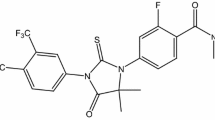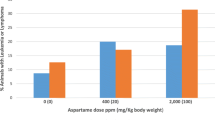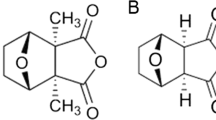Abstract
Elmiron (sodium pentosan polysulfate) is used for the relief of urinary bladder pain associated with interstitial cystitis. The National Toxicology Program (NTP) tested this compound because of its orphan drug status and lack of information about its chronic toxicity and carcinogenicity. Groups of 50 male and 50 female F344/N rats were given Elmiron in de-ionized water by gavage at doses of 0, 14, 42, or 126 mg/kg to males and 0, 28, 84, or 252 mg/kg to females once daily, 5 days per week, for up to 2 years. The same numbers of male and female B6C3F1 mice were dosed similarly with 0, 56, 168, or 504 mg/kg. Elmiron administration produced no effect on the body weight of rats, male mice, or low- and mid-dose groups of female mice. The body weights of the high-dose female mice were significantly decreased relative to those of controls. Pairwise comparison showed that survival of all dosed groups of rats and mice was similar to that of the controls. Elmiron was not carcinogenic in F344/N rats. An increased incidence of liver hemangiosarcoma provided evidence of some carcinogenic activity for Elmiron in male B6C3F1 mice. Increased incidences of liver hemangiosarcoma, hepatocellular neoplasms (predominantly adenomas), and malignant lymphomas revealed carcinogenic activity of Elmiron in female B6C3F1 mice. Elmiron administration produced elevated occurrences of nonneoplastic lesions, such as vacuolated histiocytes in the rectum, lung, spleen (males only), and mesenteric lymph node in rats and liver, rectum, mesenteric lymph node, and spleen in mice. Myxomatous change, chronic inflammation, and squamous metaplasia (mice only) were observed in the large intestine, and lymphohistiocytic hyperplasia was found to be increased in the spleen of rats of both sexes treated with the highest dose. In the latter lesion, the histiocytes contained pale, finely granular cytoplasm and were not considered to represent the same change as the vacuolated histiocytes seen in the mesenteric lymph node and rectum. Under the conditions of these 2-year studies, Elmiron was carcinogenic to mice but not rats.






Similar content being viewed by others
References
Alshak NS, Cocjin J, Podesta L, van de Velde R, Makowka L, Rosenthal P, Gella SA (1994) Hepatocellular adenoma in glycogen storage disease type IV. Arch Pathol Lab Med 18:88–91
Alza Corporation (1998) Elmiron (pentosan sulfate, sodium): questions and answers about interstitial cystitis and about Elmiron therapy. Available online via http://www.elmiron100.com
Bailer AJ, Portier CJ (1988). Effects of treatment-induced mortality and tumor-induced mortality on tests for carcinogenicity in small samples. Biometrics 44:417–431
Boorman GA, Montgomery CA Jr., Eustis SL, Wolfe MJ, McConnell EE, Hardesty JF (1985) Quality assurance in pathology for rodent carcinogenicity studies. In: Milman HA, Weisberger EK (eds) Handbook of carcinogen testing. Noyes Publications, Park Ridge NJ, pp 345–357
Carmeliet P (2000) VEGF gene therapy: stimulating angiogenesis or angioma-genesis? Nat Med 6:1102–1103
Cox DR (1972) Regression models and life tables. J R Stat Soc B34:187–220
Dencker L, Tengblad A, Odlind B (1985) Preferential localization of 3H-pentosan polysulfate to the urinary tract in rats. Acta Physiol Scand 124 [Suppl 542]:351
Fischer AM, Merton RE, Marsh NA, Williams S, Gaffney PJ, Barrocliffe TW, Thomas DP (1982) A comparison of pentosan polysulfate and heparin. II: Effects of subcutaneous injection. Thromb Haemost 47:109–113
Haagsma EB, Smith GP, Niezen-Koning KE, Gouw AS, Meerman L, Slooff MJ (1997) Type IIIb glycogen storage disease associated with end-stage cirrhosis and hepatocellular carcinoma. The liver transplant group. Hepatology 25:537–540
Herman JR, Dethloff LA, McGuire EJ, Parker RF, Walsh KM, Gough AW, Masuda H, de la Iglesia FA (2002) Rodent carcinogenicity with the thiazolidinedione antidiabetic agent troglitazone. Toxicol Sci 68:226–236
Ishioka T, Kuwabara N, Fukuda Y (1985) Induction of colorectal adenocarcinoma in rats by amylopectin sulfate. Cancer Lett 26:277–282
Ishioka T, Kuwabara N, Oohashi Y, Wakabayashi K (1987) Induction of colorectal tumors in rats by sulfated polysaccharides. Crit Rev Toxicol 17:215–244
Joffe S (1976) Drug prevention of postoperative deep vein thrombosis. A comparative study of calcium heparinate and sodium pentosan polysulfate. Arch Surg 111:37–40
Kaplan EL, Meier P (1958) Nonparametric estimation from incomplete observations. J Am Stat Assoc 53:457–481
Marsh NA, Peyser PM, Creighton LJ, Mahmoud M, Gaffney PJ (1985) The effect of pentosan polysulfate (SP54) on the fibrinolytic enzyme system-a human volunteer and experimental animal study. Thromb Haemost 54:833–837
Marshall JL, Wellstein A, Rae J, DeLap RJ, Phipps K, Hanfelt J, Yunmbam MK, Sun JX, Duchin K, Hawkins MJ (1997) Phase I trial of orally administered pentosan polysulfate in patients with advanced cancer. Clin Cancer Res 12:2347–2354
NTP (National Toxicology Program) Data Base (2002) Data of completed studies. Available online via http://ntp-server.niehs.nih.gov/main_pages/NTP_ALL_STDY_PG.html
Nyska A, Moomaw CR, Foley JF, Maronpot RR, Malarkey DE, Cummings CA, Peddada S, Moyer CF, Allen DG, Travlos G, Chan PC (2002a) The hepatic endothelial carcinogen riddelliine induces endothelial apoptosis, mitosis, S phase, and p53 and hepatocytic vascular endothelial growth factor expression after short-term exposure. Toxicol Appl Pharmacol 184:153–164
Nyska A, Nold JB, Johnson JD, Abdo K (2002b) Lysosomal storage disorder induced by Elmiron following 90-days gavage administration in rats and mice. Toxicol Pathol 30:178–187
Odlind B, Dencker L, Tengblad A (1987) Preferential localization of 3H-pentosanpolysulphate to the urinary tract in rats. Pharmacol Toxicol 61:162–166
Oohashi Y, Ishioka T, Wakabayashi K, Kuwabara N (1981) A study on carcinogenesis induced by degraded carrageenan arising from squamous metaplasia of the rat colorectum. Cancer Lett 14:267–72
Piegorsch WW, Bailer AJ (1997) Statistics for environmental biology and toxicology, Section 6.3.2. Chapman and Hall, London
Portier CJ, Bailer AJ (1989) Testing for increased carcinogenicity using a survival-adjusted quantal response test. Fundam Appl Toxicol 12:731–737
Scully MF, Weerasingle KM, Ellis V, Djazaeri B, Kakker VV (1983) Anticoagulant and anti-heparin activities of pentosan polysulfate. Throm Res 31:87–97
Siciliano M, De Candia E, Ballarin S, Vecchio FM, Servidei S, Annese R, Landolfi R, Rossi L (2000) Hepatocellular carcinoma complicating liver cirrhosis in type IIIa glycogen storage disease. J Clin Gastroenterol 31:80–182
Stefanski SA, Elwell, MR, Sromberg PC (1990) Spleen, lymph nodes, and thymus. In: Boorman GA, Eustis SL, Elwell MR, Montgomery CA Jr, MacKenzie WF (eds) Pathology of the Fischer rat. Academic Press, San Diego CA, pp 369–394
The Merck Index (1996) Twelfth edn, Budavari S (ed). Merck and Company, Whitehouse Station NJ, p 1227
Vinazzer H (1986) Clinical studies on the fibrinolytic action of pentosan polysulfate. Folia Haematol Int Mag Klin Morphol Blutforsch 113:272–277
Acknowledgements
We thank Ms. Jo Anne Johnson for editorial assistance and Drs. June Dunnick and Fernando Suarez for their scientific review of this manuscript. Experiments complied with the laws of the United States where they were performed.
Author information
Authors and Affiliations
Corresponding author
Additional information
The studies were conducted at Battelle, Columbus, OH, USA.
Rights and permissions
About this article
Cite this article
Abdo, K.M., Johnson, J.D. & Nyska, A. Toxicity and carcinogenicity of Elmiron in F344/N rats and B6C3F1 mice following 2 years of gavage administration. Arch Toxicol 77, 702–711 (2003). https://doi.org/10.1007/s00204-003-0472-9
Received:
Accepted:
Published:
Issue Date:
DOI: https://doi.org/10.1007/s00204-003-0472-9




